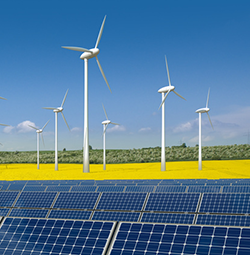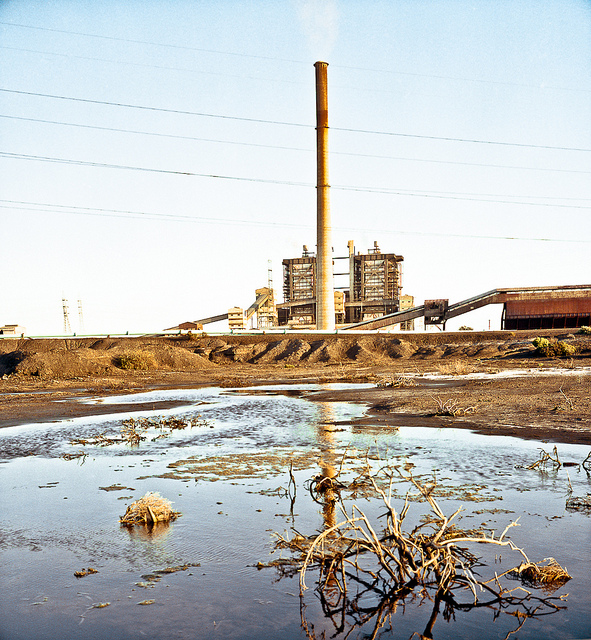
The last coal miners in South Australia have hung up their helmets, and the last coal fired power station has shut its doors.
History has been made with the closure of the Northern Power Station which has eliminated the use of coal in South Australia. And I say good riddance to you, Northern Power Station. I’m sorry you are no longer providing employment for people in Port Augusta or at the Leigh Creek coal mine, but I’m not sorry you are gone because you kill people and I am a firm believer that electricity generation should be death light.
South Australia is the first state to have washed its hands of an existing coal generation industry and expanding wind power and rooftop solar capacity made this possible. The state now has no baseload generators. Last time this happened was when we had a carbon price and the Northern Power Station closed down during winter.
The state’s only coal mine at Leigh Creek; which supplied low quality, sub-bituminous, brown coal; closed in November. The Northern Power Station was scheduled to close in March.
But since the miners had done such a bang up job of ripping fossilized trees out of the ground in their last few months of work, the power station had enough coal to keep operating for two more months.
No Baseload Generation – No Problem!
With the closure of the Northern Power Station, South Australia no longer has any generating capacity that operates in baseload mode. That is, there is no generation that runs continuously night and day and only stops for maintenance or repairs. And this is not a problem. We know it’s not a problem because the state has done it before.

Baseload power is like bacon and eggs
Some people insist that electricity grids need baseload generators, but I’m afraid those people are as nutty as lumpy chocolate bars and have confused a habit with necessity. It is like someone saying, “I always eat bacon and eggs for breakfast, therefore bacon and eggs are necessary for me to function!” Those people need to chill and eat their muesli. We have had plenty of experience running an entire state without any generators operating in baseload mode in the past, and we will have no problem now. South Australia serves as a model to the rest of the country, and the world, in how to happily run a grid without baseload generators.
South Australia Does Not Import Baseload Power From Victoria

SA does not import baseload from Victoria
South Australia is a net electricity importer, which means it takes more electricity from Victoria than it gives back. Large, brown coal, baseload generators produce most of the electricity imported into the state is produced by; but that does not mean electricity imports act like a baseload generator for South Australia. For that to be the case electricity would have to be imported more or less continuously and that does not happen. Sometimes electricity is imported from Victoria and sometimes it is exported to Victoria. Generally, South Australia imports when demand is high and exports when demand is low. So electricity imports act like a load following generator that operates some of the time and not a baseload generator that operates all the time.
It Was Renewables That Killed The Beast
The death of coal generation in South Australia was a direct result of the state’s growing renewable energy capacity. According to the Australian Electricity Market Operator, or AEMO, in the 2014-15 financial year 34% of electricity generated in the state came from wind power while 7% came from rooftop solar. Because South Australia is a net importer of electricity this means around 30% of the electricity consumed in the state that year came from wind and around 6.4% from rooftop solar, for a total of approximately 36% renewable energy. Now that wind turbine erection has commenced again in South Australia after a long politically related rest and rooftop solar installation has continued, the state’s electricity consumption may now be around 40% renewable or more.

The guilty parties
Whenever wind and solar power generate electricity, it reduces the amount produced by fossil fuels. This happens for two reasons. Firstly, it would be really stupid to use environmentally destructive fossil fuel generation when there is clean renewable energy available. And secondly, wind and solar have no fuel cost, so it always makes economic sense to use their electricity when it’s available instead of sources that have to pay for fuel.
Because the fuel cost to produce a kilowatt-hour of electricity from natural gas is higher than to produce a kilowatt-hour of electricity from coal, you might expect South Australia to close natural gas power stations before coal. And to an extent, this has happened, as half a highly efficient modern gas plant is currently sitting in mothballs at Pelican Point, and there are 4 tatty old inefficient gas generators that sit around doing nothing all day on Torrens Island, but the state’s last coal power station was shut down rather than more gas capacity, because wind and solar power are especially damaging to the economics of coal generation.
Northern Power Station To Grid – “I Can’t Stop Myself!”
While the Northern Power plant had lower fuel costs than gas generators, it had a problem in that it didn’t like to shut down. Australia’s coal power plants are all made to run continuously under constant temperature and pressure. They can normally function from about 60-100% of maximum output and that’s it. If they want to go below 60% they have to shut down and coal power stations hate shutting down because each time they do it effectively costs them money because letting the system lose pressure and cool down damages it. Temperature and pressure changes cause metal to expand and contract which weakens it and places pressure on joints and seams which can then break and burst, requiring expensive repairs or potentially even a tragic funeral.

The Northern Power Station: photo Gary Sauer-Thompson
Because of this, coal power stations can’t shut down to avoid periods of low electricity prices caused by high wind and/or solar production. Instead they choose to continue to run at a loss. Two weeks ago in South Australia, because of a warm night and high wind production, the wholesale price of electricity paid to grid generators fell to zero. But because they didn’t want to shut down even though they were receiving no money for the coal they were burning, the Northern Power Station continued to supply electricity which resulted in the grid receiving too much power. Now when this happens, to force generators to stop supplying electricity and to encourage large electricity users to consume more, prices go negative. That means for a 5 hour period the Northern Power Station had to pay money for each kilowatt-hour of electricity it generated.
Obviously, having to pay money to produce electricity severely annoys coal power stations. In fact, I’m surprised they didn’t just turn it off, saying, “Meh! We’ll shut it down and if it doesn’t start up again, too bad! We’ll close a couple of weeks early!” However, if they were under contractual obligation to supply ancillary services to the grid, that may not have been possible.
It is these negative price events combined with a general reduction in wholesale electricity prices caused by renewable energy that forced the Northern Power Station to close. Gas power stations are much better at stopping and starting and so they are not affected nearly as much.
Rooftop Solar’s Reliability Helped Close The Northern Power Station
The wind does not blow all the time. However, it does blow most of the time. And because South Australia’s wind farms are fairly wide apart this means that if the wind isn’t blowing at one wind farm it can still be blowing at another. As a result, the AEMO considers wind power in the state to be 9.9% firm in summer and 6.9% firm in winter. This means the state’s windfarms are relied upon to produce at least 9.9% of their total capacity basically all the time. That is, as reliably as a coal or natural gas power station.
In the winter the figure is only 6.9% because the winds aren’t as constant, but this lower amount isn’t much of a problem as maximum demand in Australia occurs in the summer due to air conditioner use. Being able to meet maximum demand is terribly important as people really don’t like it when the grid craps out on them and forces them to sweat to stay cool.
If a grid has trouble meeting maximum demand then it’s not possible to close down existing power stations because as soon as a summer heatwave comes along a heap of hot and cranky people will be after your hide. The fact that wind power is 9.9% firm in summer means it helps contribute to meeting peak demand, but the renewable energy source that really shines in this area is solar power.
Solar power is extremely reliable. For as long as the sun is up, it produces power. Cloudy conditions will reduce its output, but there will always be some generation. And since maximum demand for electricity always occurs on hot, cloudless, summer afternoons, solar is always available to help meet it. When it comes to meeting maximum electricity demand, it is far more helpful per watt of capacity than wind. And because of it, there is no problem in meeting maximum demand, so the Northern Power Station can be closed without creating a shortfall in electricity supply.
The Future Of South Australia’s Electricity Supply
With the closure of the Northern Power Station there will be an increase in natural gas use as gas generators fill the gap in supply. And this is an improvement. While natural gas generation is far from good, it is much less fatal than burning coal. The local pollution it causes is far less severe and its greenhouse gas emissions are considerably lower.
In addition there will also be a slight to moderate increase in electricity imports from Victoria. Since electricity that comes from Victoria is almost all produced from dirty brown coal, using it to replace electricity produced by dirty brown coal is basically a wash.
But the good news is, the increase in natural gas use and electricity imports should only be temporary. Now that wind turbine construction has started again and as rooftop solar continues to expand, natural gas use will soon be on the downward trend it was on before the coal plant closure. And increased renewable production will mean less dirty electricity will be imported from Victoria and more clean electricity will be exported to it which will make life difficult for coal generators there and help force them to close down. And this is very important as Victoria may have the most CO2 intensive electricity generation in the world.
The Future Of Australia’s Electricity Supply
South Australia is now an obvious rebuttal to anyone who still somehow thinks that baseload generators are necessary for a grid to function. The state has no source of electricity that operates in baseload mode and this includes electricity imports from Victoria. South Australia has also made the way forward clear for the rest of the nation. Keep expanding renewable capacity until it is no longer economical for coal power to keep operating and we can kill coal before it kills too many more of us.

 RSS - Posts
RSS - Posts



The Office of The Government Economist report that in 2014, total South Australian electricity production was13,187GWh
Consumption is given as 15,974GWh.
A deficit of 2,787GWh.
AEMO say that in 2014, South Australia imported 2,000GWh via interconnects with Victoria, representing 12% of consumption. Exports were 400GWh.
The interconnect limits power to 460MW or less. If run at that level 24 hours/365 day the total woud be 4,029GWh. The baseline generator is located across a border, but called upon when needed.
If it is called upon when necessary then, by definition, it is not baseload.
The glib answer – but if it is always necessary then it is. I’d love to see 100% renewable [non-carbon] energy generation but the numbers here are not yet convincing – 12% is still high [~3 hours in a day], especially if it represents the same hours of the [presumably] night. Can we get more detail on this imported energy?
RF, electricity is imported into South Australia from Victoria whenever the price in Victoria is lower and transmission capacity isn’t constrained. The large bulk of Victorian generation consist of very greenhouse gas intensive brown coal power stations, but there is also, gas, wind, and hydro in the mix. South Australia exports electricity to Victoria whenever the price there is lower. For example South Australia exported a great deal of wind energy very early this morning and tends to import when demand is high and wind and/or rooftop solar production is low.
There are two connectors from SA to VIC. Murraylink which is a 220 megawatt HVDC line and possibly the world’s longest underground transmission system. And there is the Heywood Connector which is 460 megawatts tops, but actual capacity depends upon the temperature and other conditions.
While South Australia imports a large amount of electricity, about 13% net for the previous 2 financial years, the state is quite capable of operating as an island without any functioning interconnectors. It doesn’t because it is cheaper not to. While no interconnectors it would make it harder to meet demand in a heatwave, the difference is not as great as one might think, as when South Australia’s grid is struggling, Victoria’s usually is too.
Because South Australia does not import electricity constantly, imports do not act as a baseload generator. Because electricity is only imported when it is economic to do so, it functions as a load following generator.
Thanks for that Ronald. Your second last paragraph answers my concerns – the economics can be fixed with a price on [brown coal] carbon and the heatwave issue [presumably a daytime problem] with more PV.
South Australia now has some of the most expensive power in the world and the subsidies are still being paid as well.
The ratio of export to import is 2000GWh imported, to
400GWh exported. Both links have power limits, because of temperature and oscillation for example, and in either direction. Import time greatly exceeds export time. Since that imported coal-fired energy is imported, and is from a baseline generator, it doesn’t go away when the link is being used for other purposes.
athomas the Heyward interconnector has been recently upgraded, plus Murraylink is also available. Finn is also right that isn’t the definition of baseload.
Yes, it has. The AC link not only provides energy, but up to 58% of power demands, as well as a source of synchronous generation.
“Specifically, the SA power system can operate securely when the Heywood Interconnector double-circuit
alternating current (AC) lines are connected, or at least one key conventional synchronous generator (e.g.,
Northern Power Station, Pelican Point, or Torrens Island) is online.”
The DC link is not currently capable of providing synchronous support.
One way or the other, the link is necessary. Call it baseline or not, SA is dependent upon Victoria’s non-stop coal-fired generators.
When SA is islanded all that’s required is another generator to offer FCAS. In fact there’s no reason why this can’t happen all the time, merely that in the competitive market Victorian generators offer the service cheaper. DC links can provide FCAS although Murraylink lacks the capacity (Basslink on the other hand does)
In any case as of now (1900 AEST on Sunday 15/5) South Australian wind generation is ZERO. Entirely reliant on gas generation and Heyward link at full import.
Ronald, well written. Your language was a little emotive at times that may affect your audience but spot on. Only have a few things to add.
SA no longer has a large manufacturing industry so that has helped to reduce baseload demand. Wind and gas work very well in synergy so there will likely be no issues meeting demand. It will also help make Latrobe Valley generators more carbon efficient per MWh as the closer to 100% capacity factor they operate the more efficient they are.
Open cycle generators such as Dry Creek may need to operate a little more due to the loss of spinning reserve at Northern but in the grand scheme of things this is trivial. Agreed it’s criminal that PPCCGT is sitting idle while TIPSA still generates to meet contractual demand. So wasteful.
Thank you, Jon. I hadn’t really considered that being able to export more electricity to South Australia at night would improve the efficiency of Latrobe Valley generation. They’ll be desperate for that since they can no longer dump power into Tasmania at night due to the broken connector. The big negative price event we had in South Australia a couple of weeks ago also affected Victoria.
But while they’ll get some temporary relief, now that the Northern is shut, I don’t think they’ll feeling too happy about their future prospects. Or at least I hope the worst couple of brown coal generators are strongly considering packing it in.
Even with a carbon price the lignite fired generators were highly profitable. The carbon price muted production from bituminous coal while leaving the more carbon intensive lignite largely unscathed. I doubt we will see Hazelwood close any time soon before 2030. They will exhaust their coal reserves before economics catches up.
Latrobe Valley generators also have the advantage of an on-site mine. Northern was a terrible way to operate with a combination of low calorific value coal combined with a lengthy rail journey.
I’m a little more optimistic. I’ve seen wholesale electricity prices hit zero recently in Victoria and there was a long negative price event of about 5 hours on a warm autumn night a few weeks ago. If the Renewable Energy Target remains intact we are likely to see a lot of renewable energy capacity built over the next couple of years which is not going to do any baseload generators any good, and while the brown coal power stations are incredibly cheap to run, that’s only the case until they need to be refurbished, which tends to be expensive. So I am hoping the “weakest link” among brown coal generators will shut down before too long.
But I would really like to see the pricing in of at least a portion of their health and environmental externalities, and I’ve got my fingers crossed that will happen before I get too wrinkly.
We’ve hit the other extreme tonight. SA is running distillate fired OCGTs with spot prices over $2000/MWh. With a functional Basslink I doubt we’ll see a repeat of lengthy negative price events for some time.
All the Latrobe Valley generators have received substantial overhauls over the past 5-10 years. They’re good for some time. The refits on Loy Yang A in particular netted significant efficiency gains. Even Hazelwood is now almost as thermally efficient as Torrens Island.
We’ll see what happens. If we told South Australians 10 years ago that the price of gas would double and then they would eliminate coal generation they’d probably find that hard to believe.
We’ll be at $10/GJ before 2019 I believe. Hopefully this results in the closure of TIPSA. SA has really proven it needs peaking rather than more baseload generation, this can be done for minimal capex with OCGTs. Fortunately wind generation in SA is strong on most hot summer days.
This is an admirable achievement for the planet but no mention is made of the Kw/h charge to the general domestic population of SA that does not yet have and cannot afford solar.
I am paying around 26c after govt. subsidy’s from my computer records which progressively divide my total bill by my usage as this takes in to account the variable rate and the supply charge and are currently around 26c (VIC)
In case Labor get in at the election and because this bill is a big chunk out of my pension especially in winter I need to know these figures before I vote as they are saying they are on a mission to reduce the use of that clever little rock we are told about in constant adverts by the mineral council.
Recurring bills are far more important to lower income and barely increasing pensioners than any other airy fairy policies that are mostly not kept.
Very true Clive. South Australia has almost the most expensive electricity in the developed world. Over reliance on antiquated gas-fired steam turbine plant is a leading cause as AGL prefer to self generate to meet contracted demand. South Australia also has extreme peaks and lulls in demand making OCGT plant the most capex friendly despite the horrendous operational costs.
I must say I find Mr Brakels article very enjoyable. I have to admit I have been trying to give up bacon and eggs for years.
I’m glad you like the articles, Muzz. But I’m sorry to say I don’t know how to help you give up bacon and eggs. Maybe you could hire a sad looking pig to watch you eat your breakfast?
Great news for SA to get rid of coal power “in state”. Hopefully the first of many (I have relatives from Morwell – coal fire at no optional cost).
Lies, damn lies and stats. Considering most of the power generated by domestic rooftop solar does not even get into the official stats as it is being used domestically (at generation point, especially on those hot summer days), I suspect the shortfall will be made up one roof at a time in the next few years. In my own case, 67% of the power my solar generates in winter is used immediately, closer to 85% in summer. Result – my “official usage” has plummeted even though the household has taken negligible other power reduction steps (yet) so our actual consumption remains pretty flat (i.e. seasonal variation only).
To Clive pensioner – solar is getting cheaper all the time, hopefully you can reduce your bill by becoming one of the abovementioned rooftops…